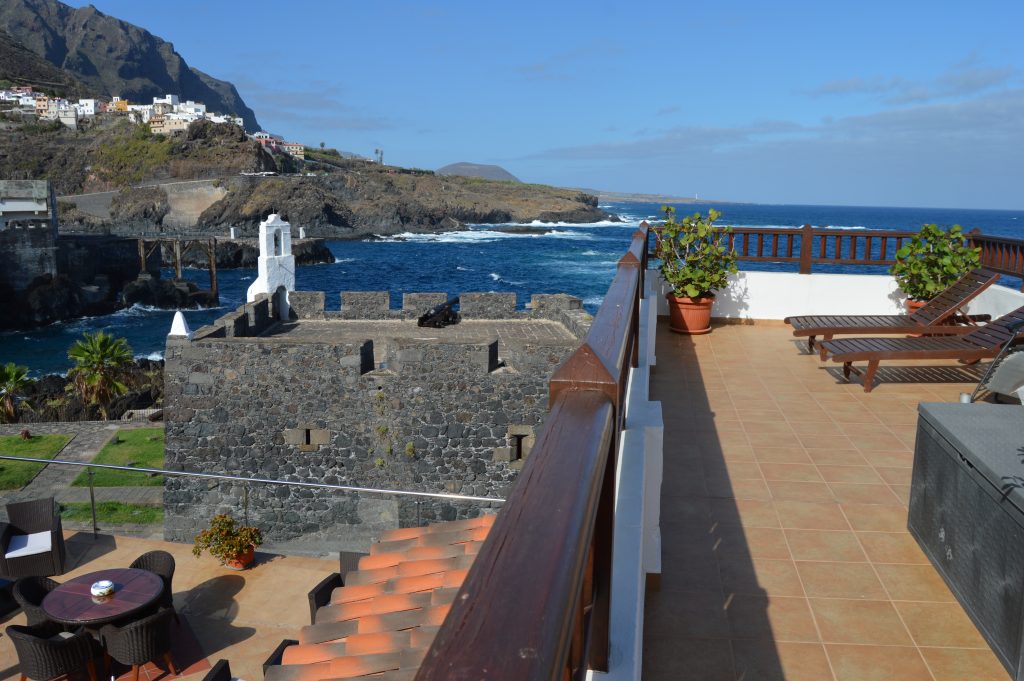Castillo San Miguel
Superviviente de la erupción
En el anterior post os hablamos de las piscinas naturales de El Caletón, que se formaron tras la erupción del volcán Trevejo de 1706. Siguiendo con este tema, hoy vamos a dar a conocer a uno de los supervivientes más famosos de dicha erupción, el Castillo de San Miguel.
Ya lo mencionamos cuando hablamos de los lugares a visitar en Garachico (http://hgara.com/category/que-ver-en-garachico-what-to-visit-in-garachico/), pero ahora queremos profundizar un poco más.
Nos remontamos a 1575, año en el que comenzó la construcción del Castillo, prolongándose hasta el año 1577 o 1587 (las fechas de finalización no están del todo claras).
Construido en piedra, ocupa 6000 m².
Encima de su puerta principal, figuran los escudos de Carlos V, del gobernador Álvarez de Fonseca (durante cuyo mandato se acabó la construcción), el de Tenerife, el de la familia Hoyo y otro, muy estropeado, que probablemente sea de la familia Viña (corregidor que sufragó parte de las obras y consiguió a cambio la alcaidía vitalicia de la fortaleza).
Se construyó para proteger a la villa de posibles ataques por mar, ya que el puerto de Garachico era el más importante y con más actividad comercial de la isla de Tenerife.
El puerto desapareció con la erupción, por lo que el Castillo perdió su función de protección.
Desde 1985 se encuentra protegido como Bien de Interés Cultural, con la categoría de monumento.
Actualmente alberga un museo, donde podemos ver la historia de Garachico y en el que destacan la erupción volcánica.

Eruption survivor
In the previous post we talked about the natural pools of El Caleton, which were formed after the eruption of the Trevejo volcano in 1706. Continuing with this theme, today we are going to introduce one of the most famous survivors of said eruption, the Castillo de San Miguel.
We already mentioned it when we talked about the places to visit in Garachico (http://hgara.com/category/que-ver-en-garachico-what-to-visit-in-garachico/), but now we want to go a little deeper.
We go back to 1575, the year in which the construction of the Castle began, lasting until 1577 or 1587 (the completion dates are not entirely clear).
Built in stone, it occupies 6000 m².
Above its main door, there are the coats of arms of Carlos V, of Governor Álvarez de Fonseca (during whose mandate the construction was completed), that of Tenerife, that of the Hoyo family and another, very damaged, that is probably that of the Viña family. (mayor who paid for part of the works and in exchange obtained the lifetime mayor of the fortress).
It was built to protect the town from possible attacks by sea, since the port of Garachico was the most important and busiest commercial port on the island of Tenerife.
The port disappeared with the eruption, so the Castle lost its function.
Since 1985 it has been protected as an Asset of Cultural Interest, with the category of monument.
It currently houses a museum, where we can see the history of Garachico and, which highlights the volcanic eruption.

